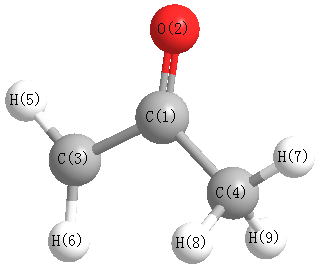Vibrational Frequencies calculated at CCSD(T)/aug-cc-pVDZ
| Mode Number |
Symmetry |
Frequency
(cm-1) |
Scaled Frequency
(cm-1) |
IR Intensities
(km mol-1) |
Raman Act
(Å4/u) |
Dep P |
Dep U |
|---|
| 1 |
A' |
3266 |
3144 |
|
|
|
|
| 2 |
A' |
3145 |
3027 |
|
|
|
|
| 3 |
A' |
3142 |
3024 |
|
|
|
|
| 4 |
A' |
3023 |
2910 |
|
|
|
|
| 5 |
A' |
1602 |
1542 |
|
|
|
|
| 6 |
A' |
1463 |
1408 |
|
|
|
|
| 7 |
A' |
1446 |
1392 |
|
|
|
|
| 8 |
A' |
1377 |
1325 |
|
|
|
|
| 9 |
A' |
1267 |
1220 |
|
|
|
|
| 10 |
A' |
1052 |
1012 |
|
|
|
|
| 11 |
A' |
915 |
881 |
|
|
|
|
| 12 |
A' |
824 |
793 |
|
|
|
|
| 13 |
A' |
514 |
495 |
|
|
|
|
| 14 |
A' |
375 |
361 |
|
|
|
|
| 15 |
A" |
3097 |
2981 |
|
|
|
|
| 16 |
A" |
1459 |
1404 |
|
|
|
|
| 17 |
A" |
1009 |
971 |
|
|
|
|
| 18 |
A" |
716 |
689 |
|
|
|
|
| 19 |
A" |
495 |
476 |
|
|
|
|
| 20 |
A" |
343 |
330 |
|
|
|
|
| 21 |
A" |
23 |
22 |
|
|
|
|
Unscaled Zero Point Vibrational Energy (zpe) 15275.8 cm
-1
Scaled (by 0.9625) Zero Point Vibrational Energy (zpe) 14702.9 cm
-1
See section
III.C.1 List or set vibrational scaling factors
to change the scale factors used here.
See section
III.C.2
Calculate a vibrational scaling factor for a given set of molecules
to determine the least squares best scaling factor.
